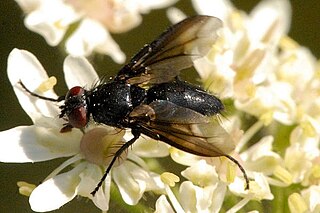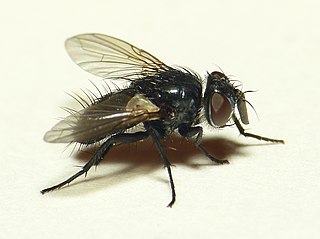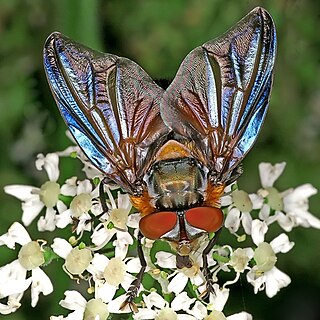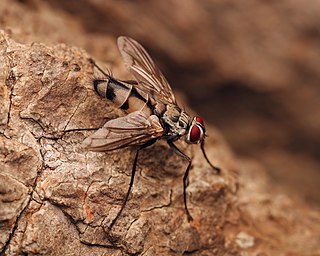
A computer worm is a standalone malware computer program that replicates itself in order to spread to other computers. It often uses a computer network to spread itself, relying on security failures on the target computer to access it. It will use this machine as a host to scan and infect other computers. When these new worm-invaded computers are controlled, the worm will continue to scan and infect other computers using these computers as hosts, and this behaviour will continue. Computer worms use recursive methods to copy themselves without host programs and distribute themselves based on exploiting the advantages of exponential growth, thus controlling and infecting more and more computers in a short time. Worms almost always cause at least some harm to the network, even if only by consuming bandwidth, whereas viruses almost always corrupt or modify files on a targeted computer.

The Tachinidae are a large and variable family of true flies within the insect order Diptera, with more than 8,200 known species and many more to be discovered. Over 1,300 species have been described in North America alone. Insects in this family commonly are called tachinid flies or simply tachinids. As far as is known, they all are protelean parasitoids, or occasionally parasites, of arthropods, usually other insects. The family is known from many habitats in all zoogeographical regions and is especially diverse in South America.

Worms are many different distantly related bilateral animals that typically have a long cylindrical tube-like body, no limbs, and usually no eyes.
Eucelatoria is a genus of flies in the family Tachinidae.
Hyphantrophaga is a genus of flies in the family Tachinidae.
Lespesia is a genus of flies in the family Tachinidae.

Actia is a genus of large flies in the family Tachinidae.

Voriini is a tribe of flies in the family Tachinidae. More junior homonyms exist of Wagneria than any other animal genus name.

Dexiinae is a subfamily of flies in the family Tachinidae.

Dexiini is a tribe of flies in the family Tachinidae.

Exoristinae is a subfamily of flies in the family Tachinidae. Most species are parasitoids of caterpillars.

Blondeliini is a tribe of parasitic flies in the family Tachinidae. Larvae are parasitoids of other insects, mostly beetles and caterpillars. Although nearly cosmopolitan, its greatest diversity is in the New World and especially in South America.

Eryciini is a tribe of flies in the family Tachinidae.

Goniini is a tribe of parasitic flies in the family Tachinidae. Members of Goniini are distinguished from other Tachinidae by laying small "microtype" eggs that hatch only after being ingested by a host.

Phasiinae is a subfamily of flies in the family Tachinidae. Except for the small tribe Strongygastrini members of this subfamily attack only Heteroptera.

Compsilura concinnata is a parasitoid native to Europe that was introduced to North America in 1906 to control the population of an exotic forest, univoltine, spongy moth named Lymantria dispar. It is an endoparasitoid of larvae and lives with its host for most of its life. Eventually the parasitoid ends up killing the host and occasionally eating it. It attacks over 200 host species, mainly insects from the Orders: Coleoptera, Lepidoptera and Hymenoptera. Since this parasite has the ability to attack many different types of hosts, the organism has spilled over from the intended forest systems into other areas, like agricultural fields, affecting cabbage pests including the cabbage looper (Trichoplusia); the cabbage worm ; and even other invasive species such as the brown-tail moth. However, it also attacks native, non-pest insects such as the Cecropia moth and American moon moth.

Tachininae is a subfamily of flies in the family Tachinidae.
Lespesia archippivora is a species of tachinid fly, which, like all tachinids, are parasitoids of other arthropods. L. archippivora lives in the body of its host resulting in its death. This is not uncommon since it is estimated that about 10% of all insects are parasitoids. L. archippivora is a generalist and able to infect at least 25 lepidopteran species in addition to one species of Hymenoptera. It is common in North America and other species exist worldwide. One study suggests the species is bivoltine.

Zelia vertebrata is a species of bristle fly in the family Tachinidae. It is a long-bodied fly with strong abdominal bristles and a distinctive abdominal pattern that resembles vertebrae. It has a widespread North American range, with records stretching from east to west from Washington to Maine, north to south from Québec to Florida. Its larval stage parasitizes beetles. It is most active during the day.
Trilobodrilus is a genus of bristle worms in the family Dinophilidae. There are about five described species in Trilobodrilus.













